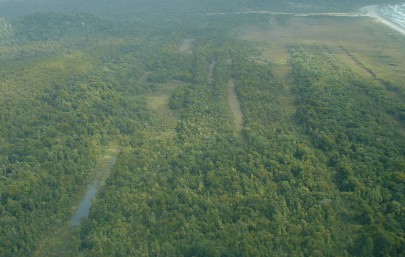Dune slacks
In this section

Dune slacks (Susan Wiser)
These are small, nutrient-enriched, vegetated, moist depressions between shore dunes or in a sandbank, especially those which periodically hold slack (scarcely moving) water at times of highest tides (Johnson & Rogers 2003). In a broader sense these ecosystems include dune hollows, deflation hollows, and swales.
Notable flora and fauna
Threatened plants include the nationally critical Gunnera hamiltonii, Sebaea ovata and Pimelea actea, nationally endangered pygmy clubrush (Isolepis basilaris), swamp hibiscus (Hibiscus diversifolius subsp. diversifolius) and Schoenus carsei. Nationally vulnerable species include the New Zealand iris (Libertia peregrinans), Lady’s tresses (Spiranthes novae-zelandiae), Machaerina complanata and dwarf musk (Mazus novaezeelandiae subsp. impolitus f. impolitus). Declining species include sand spike sedge (Eleocharis neozelandica), Gunnera arenaria, dwarf woodrush (Luzula celata), pygmy forget-me-not (Myosotis pygmaea var. pygmaea), sand daphne (Pimelea villosa), P. lyallii, and Selliera rotundifolia and Ranunculus recens var. recens are in gradual decline. Relicts include pingao (Ficinia spiralis). The Chatham Island geranium (Geranium traversii), sand musk (Mazus arenarius), Leptinella traillii subsp. pulchella, Myriophyllum votschii and L. traillii subsp. traillii are naturally uncommon.
Notable birds include declining endemic fernbird (Bowdleria punctata).
We have no information on threatened invertebrates.
Threat status
Endangered (Holdaway et al. 2012)
Threats
Weed invasion is intense in places, especially near urban centres. Several water- and salt-tolerant weeds, e.g. creeping bent (Agrostis stolonifera), tall fescue (Schedonorus phoenix), also Pinus spp., and garden escapes, all have potential to displace and/or overtop native species.
Historically, extensive dunelands were converted into farms and forestry. Very few unmodified dunelands remain. Dune slacks in agricultural settings are grazed, trampled, and highly modified. Very few are fenced. Nutrient enrichment from fertiliser and stock, and drainage, are problems in agricultural settings. There is pressure on coastal systems as urban centres spread in highly sought after coastal locations. Some remote areas are less affected.
Exotic bird species (taking fruits from native plants), rabbits, hedgehogs and snails may be affecting regeneration of native plant species as well.
Natural dune-building processes cause local erosion; however, coastal erosion is a natural process.
Recreation can have impacts in places, especially near urban areas with off-road vehicles such as dune buggies, etc.
Climate change does pose a threat to small isolated systems.
Where do they occur?
Dune slacks are widespread in association with active sand dunes and occur in many coastal areas of the North, South and Stewart islands, and on some offshore islands as well.
Further reading
Cameron EK 2005. Field Trip: Bombing Range, Waionui Inlet, Kaipara South Head. 19/03/05. Auckland Botanical Society Journal 60: 17–21.
Champion PD, Reeves PN 2009. Factors causing dune ephemeral wetlands to be vulnerable to weed invasion. DOC Research & Development Series 310. Wellington, Department of Conservation. 53 p.
Hilton M, Macauley U, Henderson R 2000. Inventory of New Zealand's active dunelands Science for Conservation 157. Department of Conservation, Wellington. 35p.
Johnson P, Gerbeaux P 2004. Wetland types in New Zealand. Wellington, Department of Conservation.
Johnson P, Rogers G 2003. Ephemeral wetlands and their turfs. Science for Conservation 230. Wellington, Department of Conservation.
Johnson PN 1992. The sand dune and beach vegetation inventory of New Zealand. II. South Island and Stewart Island. DSIR Land Resources Scientific Report Number 16, DSIR Land Resources, Christchurch. 278 p.
Pegman APM, Rapson GL 2005. Plant succession and dune dynamics on actively prograding dunes, Whatipu Beach, northern New Zealand. New Zealand Journal of Botany 43 223-244.
Roxburgh SH, Wilson JB, Gitay H, King WMcG 1994. Dune slack vegetation in Southern New Zealand. New Zealand Journal of Ecology 18: 51-64.
Young M 1997. Field trip to Sand Island, Okahukura Peninsula, Kaipara Harbour 15 March 1997. Auckland Botanical Society Journal 52: 18-19.


